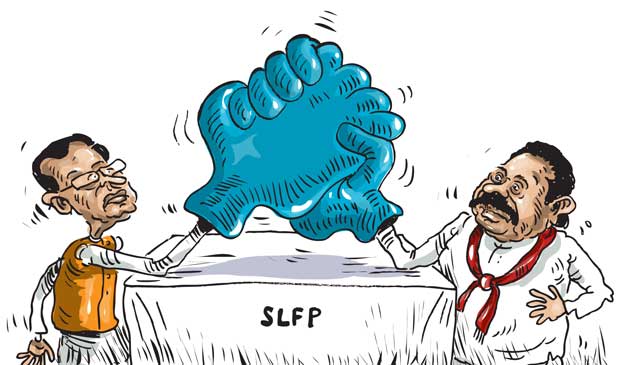A Brief Colonial History Of Ceylon(SriLanka)
Sri Lanka: One Island Two Nations
A Brief Colonial History Of Ceylon(SriLanka)
Sri Lanka: One Island Two Nations
(Full Story)
Search This Blog
Back to 500BC.
==========================
Thiranjala Weerasinghe sj.- One Island Two Nations
?????????????????????????????????????????????????Thursday, July 20, 2017
Who represents the real SLFP… Maithri or Mahinda ?

“You cannot swim for new horizons until you have courage to lose sight of the shore.”
~ William Faulkner
~ William Faulkner
- MR practiced economic policies, same as CBK’s crony-capitalist principles
- MS’s rise in SLFP’s hierarchy is noteworthy and his current struggle to keep together is extraordinary
Sri Lanka Freedom Party (SLFP), although purported to be following the
Bandaranaike policies and principles, basically consists of socialized
economic principles and hard nationalism bordering on extremism. Its
fundamental appeal has been to Sinhalese Buddhists who it rightly
assumed as marginalized and under-served by the then governing
principals, a Colombo-based, English-speaking elite led by the United
National Party (UNP). That is all post-Independence politics in Ceylon.
However, prior to Ceylon obtaining freedom from the British Raj, in both Councils, Legislative and State, amongst the dominating elements, the most striking was its composition that of a foreign cum English-educated, whiskey-drinking, impervious super-elite whose allegiance to and being arrogant towards the local culture of the average Haramanis. Haramanis was nurtured and nursed by the glorious tales of the Great Chronicle - Mahawansa. Living in the rural countryside, nourished by the soil of the land and its meagre fruits of rain-fed cultivations, the average Sinhalese Buddhist was literally kept in the dark. His wants and desires were not heard nor adhered to. His culture which boasts of thousands of years of monarchical rule by Kings and Queens was rooted in aggressively held beliefs and unforgiving faith in a religion that is sacred and universally accepted as a supreme philosophical teaching of life and living. They were proud of that faith and rightly so.

The then decision-makers who were mainly part and parcel of the establishment comprising of the colonial powers and Colombo-based elites executed their legislative callings with an exclusive mindset of arrogance on the one hand and a reprehensible sense of oblivion on the other. This mindset of the ruling elites was dictating the performance of its obligations without any substantial relationship to the great majority in the land whether they were Sinhalese, Tamil or Muslim. But the appeal of the SLFP, as per historical records, is essentially a logical progression of the Sinhala Maha Sabha, ‘founded by SWRD Bandaranaike in 1934-35, in order to promote Sinhalese culture and community interests’. While retaining its fundamental nationalistic character, the SLFP also promulgated a message of vastly different economic policies- policies that later implemented as ‘socialist’ and ‘common man-friendly’- from the UNP’s capitalistic free-market-friendly approach.
When the govt was formed as Mahajana Eksath Peramuna coalition with well-known Marxists/Trotskyites like Philip Gunawardene at the helm of the Ministry of Agriculture, Food, and Co-operatives, the direction in which the govt was taking the country was obvious. Undoing of capitalist economic structures continued whenever any govt led by the SLFP was in power, until Chandrika Bandaranaike Kumaranatunga (CBK) assumed office as President in 1994, thanks mainly to the assassination of Gamini Dissanayake by the LTTE. Had Gamini not been taken out of the scene, it might have been a UNP-led govt in power in the wake of the 1994 Presidential Elections. Well that, as they say, is history now.
Coming back to the major policies and principles adopted by successive SLFP-led governments up to CBK, both of economic and national significance, a radicalisation of the country’s national posture, as a third-world nation advancing towards embracing oncoming modernization and rejecting archaic feudalistic strangulation of man’s inherent thirst for freedom, changed for good. The Pancha Maha Balavégaya unleashed a more radical force whose anger and rile were difficult to control and contain. Degradation of parliamentary debating, a custom of unpublishable vernacular barrage, both within and outside the ‘House of the People’, political power being misunderstood and misplaced by an uneducated class of parliamentarians contributed to an eventual decay in the national polity. Not that this did not happen under the UNP-led governments, but the difference between the two is too stark to ignore.
The SLFP became the party of the ‘common man’. The so-called underprivileged and déclassé found a proverbial ‘place in the sun’. That is indisputable and remained so until the early 70s when JR took control of the UNP, the so-called ‘rich man’s party’.
It is in this context one has to look at Mahinda Rajapaksa (MR), the former leader and Maithripala Sirisena, the current one of the SLFP. Both are typical by-products of the 1956-transformation. In so far as the 1956-change is concerned, I deliberately use the term ‘transformation’ instead of the more commonly used term ‘revolution’. There were only two attempts at a revolution in the country. The first was in 1971 and the second in the 1987-89 period. However, the change that the Bandaranaike-led SLFP government entailed in 1956 was gleefully hugged by a large majority of Sinhalese Buddhists in the country. That character of the SLFP is still valid and vastly accepted as a ‘given’ in the context of closely fought election battles.
MR is one of the sons of D. M. Rajapaksa, one of the pioneers of the SLFP. MR’s allegiance to democratic principles and commitment to the elevation of the ‘common man’s status is recorded history. But that was in the early 90s when he was in the Opposition, specifically during the Premadasa-regime, leading a sleeping SLFP in Paada Yaatra marches. None can dispute MR’s dedication to the cause of the party in which his father was one of the pioneer members along with A. P. Jayasuriya, Sri Nissanka and of course, SWRD Bandaranaike. MR while reflecting the fundamental ethnic profile of the party, that of ultra-nationalist and pseudo-patriotic, he practised economic policies that were same as those of CBK’s crony-capitalist principles.
One of the greatest ironies in the SLFP’s practice of economic policies was when CBK’s mother who was primarily responsible for enacting the Land Reform Bill, which its opponents called ‘draconian’, CBK in fact was one of the key officials who were responsible for implementing Sirimavo’s Land Reform policy. The irony is, it was CBK herself who was responsible for the undoing of most of the policies enacted by her mother. Privatization of management of the vast business empire of Tea Estates in fact rectified that grave economic mistake done unto Sri Lanka’s economy. Mahinda embracing crony-capitalism and practising it with blind allegiance to his kith and kin ultimately led to his fall. The passage of the Nineteenth (19th) Amendment further confirmed MR’s cavalier attitude towards ‘others’ and the concerns and needs of the ‘common man’. To disregard so ungratefully the very entity that rendered loyal and unstinting support at successive elections is an unforgivable wickedness. And MR paid a very severe price for that wickedness.
Maithripala Sirisena (MS), a product of the same traditions and practices of the SLFP had a rare quality a very few in that party have displayed so far. Standing against the party leader, the sitting President of the country requires more than conviction and courage. It needs ‘guts’. In that deed, MS stands alone. And MS’s scrutiny into the unjust displacement of the Northern Tamils and his commitment to a speedy solution to making ground for those unfortunate Tamils in the North is ample evidence of a clear departure from the traditional postures of the SLFP. In this sphere, MS is closer to CBK than anyone else in the SLFP history except perhaps SWRD himself. Although the latter was considered a ‘liberal’ in Sri Lanka’s history, his lack ‘guts’ led to the doing away with the so-called BC Pact and his disconnect with the country’s agony during the 1958 anti-Tamil riots has also been penned in history.
In short, MR might be an aberration while MS is a true product of the SLFP. Adherence to the founding principles of the Party matters. It matters prior to, during and after elections. While the former erased much of the traditional aspects of the Sri Lanka Freedom Party, the latter being an outsider of a ‘family clan’ is trying to embrace and advance the cause of the party. Whether such adherence to the SLFP principles is valid today is another question and in this writer’s opinion, such allegiance should not be blind nor should it be unwise.
In a rapidly changing environment, where the social media is overtaking each news cycle in double-quick time, authenticity of a politician is most critical in the eyes of the public. That sense of authenticity belongs to MS. Having started his professional life as Grama Niladhari and risen to the pinnacle of Presidency of the country is no mean accomplishment. His rise in the SLFP’s hierarchy alone is noteworthy and his current struggle to keep the SLFP together is extraordinary. He might succeed and sometimes fail. But the journey of the SLFP has been and is not uneventful. Having shown that he is a far better public speaker than MR, MS might indeed have an easier task in convincing the majority in the country. But he might be running into an impregnable wall within his own party. How far his authenticity would carry him is a matter not yet resolved. MR’s acts of connivance might overshadow MS’s authenticity. In such a battle, MS will succeed, come what may.
The writer can be contacted at vishwamithra1984@gmail.com


